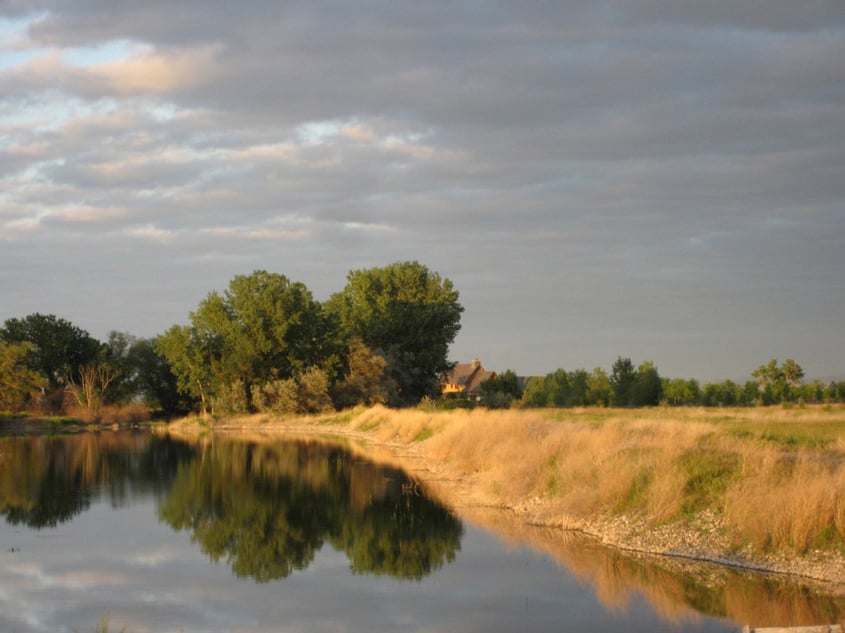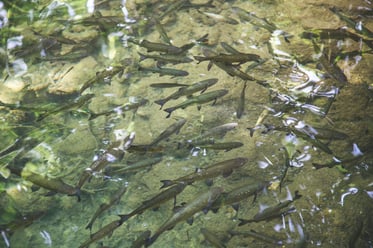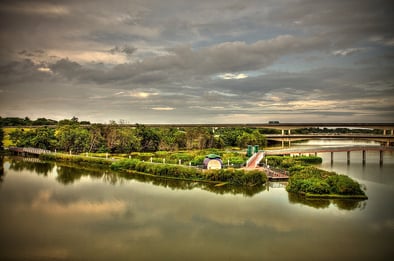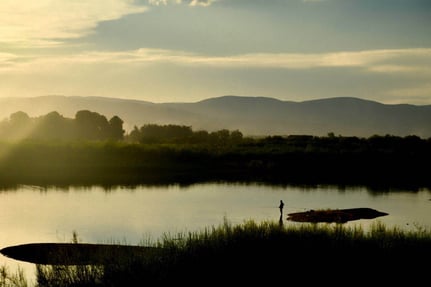
When your best mate, or, in this case, best mutt, leads you to the career of a lifetime, it has to be fate.
That’s what happened to Bruce Kania, founder, CEO, President and Research Director of Floating Island International over fifteen years ago.
Rufus, a swim-loving lovable mutt, spent his free time taking laps in late summer on a pond on Bruce and his wife Anne’s 340-acre home along the Yellowstone River northeast of Billings, Montana. The land was idyllic. It had water, wildlife, gorgeous sunset views and a pond, where black-furred Rufus would emerge after his swim a questionable shade of red. And he’d stink.
So, maybe that part wasn’t so idyllic.
Worried about the pond, and the stench coming in waves off his dog, Bruce sought the advice of friends who worked at Montana State University. They told Bruce that the worrisome reddish hue coating Rufus was actually cyanobacteria.
Bruce asked what he could do. And a new career began.
When Nature Has More To Offer
Unwilling to fight the modern world’s problems with simply more chemicals, Bruce set out to biomitigate his land. In other words, he wanted to mimic what nature does anyway, but at a scale and timeline that could be replicated in other areas and for other issues.
Recalling his time as a fishing writer in northern Wisconsin, Bruce remembered the naturally occurring floating islands and hyper-productive wetlands scattered in that part of the world - a landscape that produced some of the highest classification of fish and premier bodies of water in the country.

In 2003, Fish Fry Lake—a 54-acre research lake on Bruce and Anne’s property in Montana—had zero fish and was 100% carpeted in algae. Using the lake and their property as the headquarters for their business, Bruce brought in biofilm engineers and plant scientists to create a solution that modeled nature to solve nutrient management issues and aid in water resource recovery.
In the early days, they went through at least 400 types of prototypes before landing on the current BioHaven technology. By 2005, Bruce opened a modest BioHaven® production facility, and within two years had launched 1,600 islands around the world.
 Since then, Floating Island International has launched over 9,000 BioHaven floating islands, each with a 60 year design life. This persistence in the market, and continual research and develop has helped FII to amass a huge portfolio with an impressive amount of data to back up the original idea – mimicking a wetland in a body of water to harvest nutrients, pollution, total suspended solids and heavy metals in a natural way to remediate degraded systems.
Since then, Floating Island International has launched over 9,000 BioHaven floating islands, each with a 60 year design life. This persistence in the market, and continual research and develop has helped FII to amass a huge portfolio with an impressive amount of data to back up the original idea – mimicking a wetland in a body of water to harvest nutrients, pollution, total suspended solids and heavy metals in a natural way to remediate degraded systems.
How Do Floating Wetlands Work?
Essentially, Floating Islands (or, Floating Wetlands), are a man-made island that floats in a body of water. We go into some pretty deep waters describing Floating Wetlands, how they can work for you, and even the ROI on Floating Wetlands, but the short version is they act like a natural wetland.
While we might see some nice native plants on a pretty little island, it’s the undercarriage that’s doing the heavy lifting and the true hero of our story. The engineers, plant specialists and experts working with Bruce at Floating Island International have developed a proprietary substance that every BioHaven Floating Wetland is outfitted with. Partially made from recycled polyester (or PET, considered the safest, most inert type of plastic), this is more than a clever way to use recycled water bottles and should not be confused with microplastics, which are a very real concern. According to their website, BioHaven’s technology can actually remove microplastics from the water with its biofilm-covered surfaces (more on that in a minute).
This material—which uses about 12 recycled PET bottles for every square foot of BioHaven floating island—is treated with a polyurea coating that acts as an “armor” helping to ensure that the material doesn’t break down over time. That same material provides extra surface area below the island to promote the growth of microbial activity. In turn, that large surface area and its corresponding sizable community of microbes is working hard to digest pollutants and nutrients in the water, which then converts them into a productive mix that the plants can use.
Of course, Bruce has a small window into those long roots. As in, an actual window where Bruce and his team can keep an eye on the islands, continually refining and improving their technology.
What’s Floating Down the Pipeline for Floating Wetlands
It might have even been that window that provided Bruce with the next phase of growth for Floating Island International. While he has been highly involved running the company, what really gets Bruce excited is knowing that the technology and research behind floating islands can be used for so much more.
Currently, Bruce is developing a “way to halt the epidemic of algal blooms we’re seeing across the country.”
Harmful algal blooms can take out entire food webs. As they get worse, and cover more surface area of a water body, they become greenhouse gas producing machines. Through his research and tireless testing, Bruce has discovered a way to cleanse these water bodies, as well as getting the islands to boost their ROI.
Installing floating islands with arrays of solar panels is the next move for Floating Island International. Still populated with native plants and grasses growing beneath the solar panels, the islands can now improve water quality, generate renewable energy, mitigate climate change (by reversing the destruction of methane producing algal blooms), improve populations of fish and protect shorelines.
Floating Wetlands Are More Than Just the Technology
When Bruce and Anne first bought their property in Montana, they intended it to be more than a home or even a place of business, but an experiment. A place of research, experimentation and development about the issues at the crossroads of wildlife and humans. “Bringing water back and reacquainting people to living next to healthy water, that’s our goal.”
Today, Fish Fry Lake, that toxic pond Rufus would splash around in, is now clear to nearly twenty feet and is the most productive lake in Montana, generating more pounds of wild fish per acre-foot of water than any other wild fishery in the state. Says Bruce, “When sunlight can penetrate deeper into a water body, it’s a beautiful thing, a wonderful loop. And nature responds.”
Meanwhile, the influence of this technology has gone beyond south-central Montana. If you’re worried that our Midwest winters will break one of these islands, Bruce would tell you not to worry.

BioHaven islands have withstood “hurricane force winds in the Gulf of Mexico, 48-inch snow dumps in the ocean off the coast of Alaska, a tornado in Montana, a typhoon in Singapore, and a two-day windstorm in Oregon.”
Rising to the challenge of the urgent need for effective, green infrastructure, BioHaven products have given us something we here at Ecogardens appreciate – a natural, sustainable solution for our clients, one with a modest stewardship model that will last for decades if properly cared for.
Like Bruce says, key to the success of FII has been creating a positive impact on the environment instead of a negative one, which chemicals would do to clean the same water body. “It’s being able to figure out how to live more gracefully within our sphere of influence.”
Founded on the belief that nature’s complex, interconnected relationships are what keeps ecosystems thriving, BioHaven is naturally, systematically reconnecting those broken relationships. It’s what keeps Bruce going, seeing species of flora and fauna return to otherwise degraded, barren ecosystems. “When you resurrect a food web, it’s like nature is on our side.”
Can’t wait to install one of these? Us too! Get in touch below, and you’ll be on your way to a natural, long term solution to keeping your water quality healthy and sustainable.
Schedule a free 30-minute consultation with our team (over a Zoom!) and we'll discuss your unique property, your options, specific do's and don'ts for incorporating a Floating Wetland into your environment, and more.
Together, let’s build an island.

